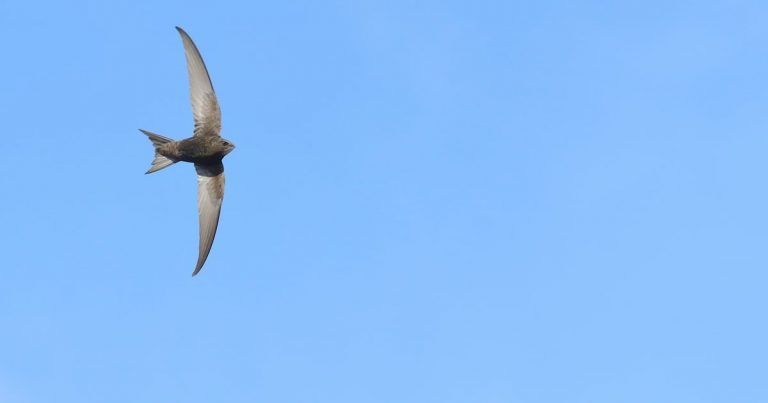Considering they weigh as little as 40 paperclips, swifts certainly make a lot of noise. As I write this article, five swifts are flying like flying madmen around the house, shrieking past the windows. Their calls wax and wan in volume in proportion to the speed of their movement, which makes for a fascinating soundscape, considering they are the fastest level-flying birds in the world.
Soon all is quiet. The adult birds, who remain together for life, arrive from Africa during the first two weeks of May, searching for the same nesting holes they’ve used all their lives. By mid-August, when the last chicks have left the nest, the adults take to the skies and silently return to their home in Central Africa. There’s no time to waste on this journey: they can travel up to 830 km in a single day.
I, like many urban Irish people, have been fortunate to have had a long and close relationship with swifts. For years they have nested under the eaves of our house. But they fly in and out of the gaps under the gutters so quickly that I often worry I am mad to think they are there. They are easy to miss, as they give no sign until just before they fly into the nest. They glide through the mist and dart out of the eaves, and by the time I try to follow their trajectory into the sky, they have vanished like a David Blaine magic trick.
One year I had the opportunity to observe it up close. After being away for a few days, I returned and found a swift perched on my second-floor windowsill. On its way back to its nest, it must have accidentally flown in through the open window under the eaves. Having evolved into a creature of the sky, its legs are short, stubby and of little use. The swift sat motionless, gazing outside. However, it was panting from dehydration, so I shoved some cotton wool soaked in water into its beak. It gulped down the cotton wool and within 40 seconds it had lifted its head up. I opened the window from below and it flew out in a flash.
I’ve written before about swifts and their amazing aerial lives. They sleep, eat and mate in the air, never landing for the first three years of their lives until they begin breeding. The closest they come to earth is when they plummet towards the lake; they open their beaks to increase resistance, skim the surface of the water, satiate their bellies and then take to the air again. Their branching silhouettes are dark against the sky.
Like salmon, swifts are loyal to their breeding sites, returning to the same nests year after year. But a lot can happen during their nine months in Africa. Buildings are renovated and nest sites are inevitably blocked off (even if unintentionally). This is one of the reasons why swifts’ numbers have fallen so rapidly (down 50 percent in 25 years) that they are now considered endangered. In 1936, “hundreds of swifts” were recorded circling above a house in Powerscourt, County Wicklow before heading off to Greystones. Nowadays you’d be lucky to see 10 of them at once.
Our urban life is linked to the fate of birds, who need breeding cavities in buildings to survive. Leaving these gaps is not necessarily compatible with insulation projects, but there is an alternative that does not cost a lot of money: “swift nest bricks” are hollow bricks with small holes for entrances that can be incorporated into new buildings, providing permanent nesting sites for the birds.
Nest boxes can also be mounted on walls. A few years ago I installed swift nest boxes made by Stephen de Beer in Kerry on the outside walls of my home and my children’s primary school. Swifts are sociable and love to be together, so playing a repeated recording of their calls from a small speaker next to the nest box attracts the attention of the young swifts, who will bounce repeatedly into the nest hole, mapping the spot as a potential future nest site.
There is also the possibility of installing swift nest boxes or bricks in public places such as sports clubs, churches, libraries and county council offices. This summer, Patrick Earls, a volunteer with Swift Conservation Ireland, installed 34 swift nest boxes on the walls of four primary schools in Dublin (St. Mark’s Tallaght, St. Louise’s Ballyfermot, Harold School Glastuhl and Scoil Iosagan Crumlin). The project was piloted in a school in Cork last year and is funded by Gas Networks Ireland and civil engineering firm Murphy. Patrick says, “It’s amazing to see these agile swifts on a summer’s evening along Dublin’s South Circular Road… considering that only a month or so ago they were gliding over the Serengeti and the Congo River in equatorial Africa.”
Soon the pair will fly away to Africa, separated from each other, to be reunited next spring. It’s a reminder of autumn’s approach and a little scary as the air gets quieter, but with the colder months approaching, it’s endearing to imagine the swifts flying over the source of the Congo River, chasing swarms of termites in the air.


